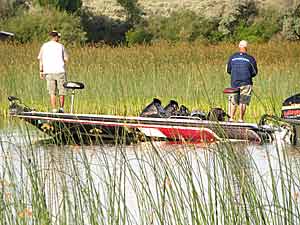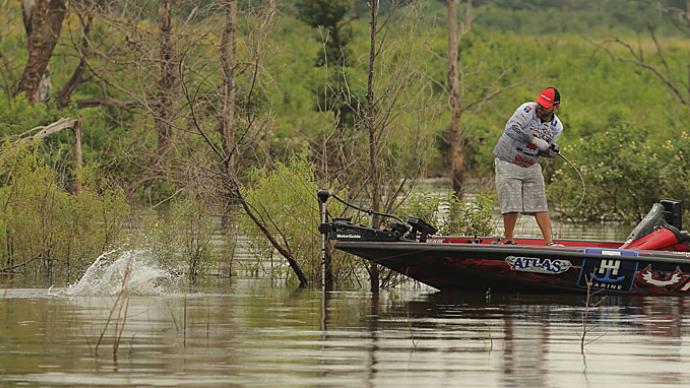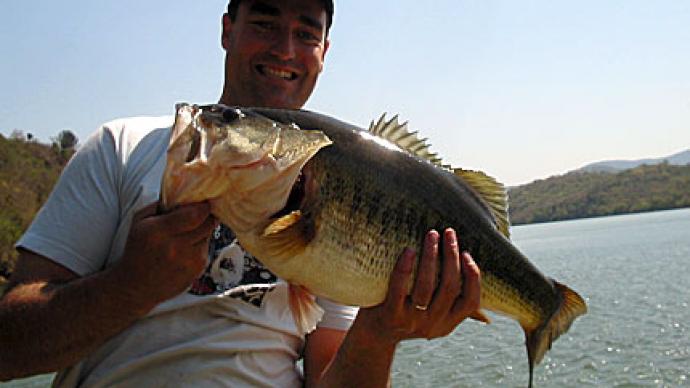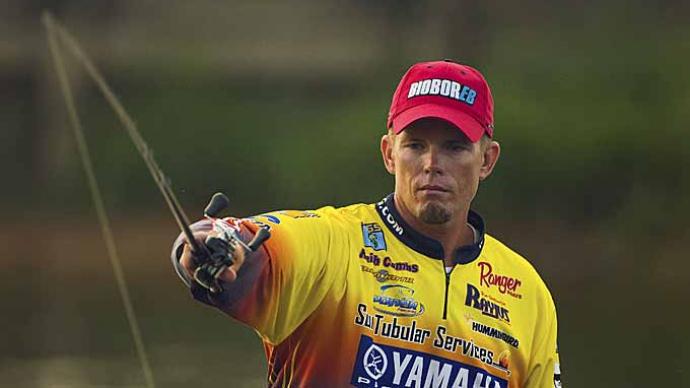
This is my strength. The essence of power fishing. The ability to present lures quietly and efficiently into heavy cover. It's one of the "must-know" techniques. It relies heavily on the mechanics part of the technique. This is great because we can practice even when we're not on the water (winter time). Most of my mechanical techniques were learned as an employee of Dick's Sporting Goods, flipping and pitching down the isles.
Learn Every Cast With Both Hands!
Different situations present themselves during the fishing day. Different situations pop up on any given stretch of bank. I can compare this to baseball and hockey. In baseball, you sometimes have to bat left-handed or right-handed, depending on the pitcher. There are times when a slap shot from the point is best in hockey, a wrist shot in front, or times when you can only get off a backhand. Well, the same goes for fishing. There are times for a longer pitch. There are times for an up-tight flip, an overhand roll, or a pitch-skip cast. Learn all of the casting techniques with both hands (left and right), and you'll become a better fisherman, ready for any situation that presents itself.
When To Do What
Flipping - best for stained to muddy water or extremely heavy cover. This is more of a short-line technique. It's quieter and more accurate than any other cast but can not achieve the distance sometimes needed.
Pitching - best suited for clearer water situations. It can achieve duplicate quiet, precise entry with a lot more distance. Better for sparser cover.
Over Hand Roll - A good technique for getting just under objects or in between branches.
Pitch-Skip is ideal for getting way back under objects (docks and laydowns). Also, even in open water, this cast presents the bait in a natural skipping/fleeing motion.
Crucial Elements Of The Cast
The Initial Fall - This is the most critical part of flipping and pitching. It's the number one thing people do wrong. The fact is that 80 percent of my strikes occur on the initial fall. Think about that! I concentrate on that initial fall more than any other part of the retrieve. The two most common errors made with the initial fall are either having a tight line or having too much slack in the line. The bait swings back away from the cover with a taut line. With too much slack, you lose control of the bait and miss all the strikes occurring in the fall. You must learn to fish with a "semi slack" line. This allows the bait to fall vertically next to the cover and allows you to pick up on strikes on the fall visually. The line might tick or jump to one side. Or your line might stop falling four feet down in eight feet of water. Learning the visuals and movements of your line become as important as the casting technique themselves.
Become A Line Watcher! - With time and practice, it becomes almost a gut feeling when to set the hook. Remember, it is better to appear the fool than be the fool. Set on anything that seems different.
The Bowing Technique - The "bowing" technique helps throw the initial amount of slack needed for the semi-slack fall. In shallow water, you don't need to do anything else. Just bow to the bait after the cast. In deep water, say water deeper than 5 feet, you must keep stripping off line at a rate to achieve the semi-slack bow. This is like patting your head and rubbing your stomach simultaneously. You will get used to it after a while.
Be A Lure Watcher - The other common mistake I see in flipping and pitching is what people look at during the cast. Just as in other sports such as baseball, where it is critical to keep eye contact with the ball, it is also critical to keep eye contact with the jig. My general procedure is that I first eye up my target. I make a mental note on where I want my bait to go. I imagine how that bass is positioned in the cover and how he will eat the bait. I then watch (follow) my jig as it proceeds to the target. Because I know what my bait is doing, I can make modifications during the cast to either slow it down or speed it up. Make your lure work for you. Don't fight it. Command your lure to get into the places you want it to.
Lures
Although I use many lure types, the Stone Jig is my number one choice. The Stone Jig is the perfect bait to complement all of the casting techniques mentioned. The shape of the head is unique. It incorporates a thee dimensional ridged head. This not only looks and feels natural but also traps air and gives off a different vibration. The flat stand-up head makes it perfect for rocks and Pitch Skipping. Also, the integrated, vertical line tie makes it tremendous for weeds and helps protect the knot. I'll use all four jig sizes depending on the conditions and casting technique. The 1/4-ounce and 3/8-ounce are best for shallower water and pitch-skipping. The 1/2-ounce and 3/4-ounce are better for deeper water and thicker cover. The best overall sizes are probably 3/8-ounce and 1/2-ounce. I choose lure color on the two essential guidelines, forage and water clarity. The white jig is an excellent shad imitator. Not many people flip or pitch baits designed to imitate shad.
Trailers
I select trailer type depending on how I'm fishing the jig. If I'm swimming the bait or I know that most of the hits are occurring on the fall, I will use an action-type trailer like a twin tail grub or an action-type Uncle Josh Craw Frog or Flippin Frog. If most of the bites are occurring after the bait has been sitting on the bottom or for less aggressive fish (cold water), I will use the traditional types of Uncle Josh Pork Trailers like the 11A, Spin 101, and Big Daddy or J-Frog plastic trailer.
Besides the Stone Jig, I also like to use plastics such as creature applications, tubes for a more subtle fall, the Lizard in any Spawn phases, and a craw, especially in thick matted vegetation.
Tackle and Equipment
I use four different rod lengths and actions. But two of them stand out as all-around rods. My number one choice is a 7-foot 3-inch pitching rod. It is the perfect in-between length and action to do all of the casting techniques mentioned. It has an 80/20 ratio. My second choice is a 7-foot SLT. This rod has a 70/30 ratio.
I also use a straight flipping stick (7-foot 6-inch) and a smaller pitching rod (6-foot 6-inch) on special occasions. In reels, I need a slim and compact reel that fits my palm nicely. I want the reel to disappear in my hand. I also need a reel with a super-fast ratio and quality anti-reverse. I use at least a 7 to 1 gear ratio.
My number one line concern is the type of cover I'm fishing around. Seventy-five percent of the time, I'll use 17 pound in clear. If the cover is extremely thick, I'll step up to 20. For dangerous cover (barnacles, sharp metal, zebra muscles), I'll use fluorocarbon in 17 or 20. In sparser cover, I'll step down to 14-pound fluorocarbon in clear. Use clear line because visual line detection is an integral part of the strike.




